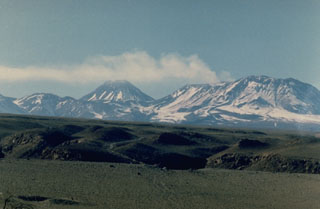Report on Lascar (Chile) — May 1987
Scientific Event Alert Network Bulletin, vol. 12, no. 5 (May 1987)
Managing Editor: Lindsay McClelland.
Lascar (Chile) Ashfall in Argentina 16 September; ash chemistry
Please cite this report as:
Global Volcanism Program, 1987. Report on Lascar (Chile) (McClelland, L., ed.). Scientific Event Alert Network Bulletin, 12:5. Smithsonian Institution. https://doi.org/10.5479/si.GVP.SEAN198705-355100
Lascar
Chile
23.37°S, 67.73°W; summit elev. 5592 m
All times are local (unless otherwise noted)
The following describes ashfall in Salta, Argentina [from the 16 September 1986 eruption (12:4)]. Chile time (GMT - 4 hours) is used instead of Argentina time (1 hour later) for consistency with observations from the volcano.
At 0830 on 16 September, an unusually high gray cloud was seen coming from the NW in an otherwise clear sky towards Salta, Argentina (350 km SE of the volcano). At 0900 fine ashfall began, continuing until about 1230. Officials from the Salta airport reported that winds at 9,000 m altitude were blowing from azimuth 300° at 145 km/hour between 1500 on 15 September and 1300 on 16 September. In Salar de Rincón (Argentina Puna) 65 km SE of Lascar, observers reported that the sky suddenly turned dark on the morning of 16 September but that no ash fell.
Ash accumulated 0.5 mm at Salta Univ and microscopic analysis showed a hypersthene andesite composition. Two ash samples were collected and leached, one with distilled water, the other with HCl (table 1).
Table 1. Leachates from samples of Lascar's ash collected at Salta, Argentina on 16 September 1987. Two ash samples were collected (0.5 kg) and leached, one with distilled water, the other with HCl (0.1 N). The ash/water ratio was 1:10 and the stirring time, 5 and 15 minutes respectively. Courtesy of J. Viramonte.
| Component | H2O (ppm) | HCl (0.1 N; ppm) |
| Cl | 890 | -- |
| SO4 | 6300 | 7000 |
| Mg | 70 | 240 |
| Ca | 500 | 1150 |
| Na | 370 | 520 |
| K | 135 | 240 |
Geological Summary. Láscar is the most active volcano of the northern Chilean Andes. The andesitic-to-dacitic stratovolcano contains six overlapping summit craters. Prominent lava flows descend its NW flanks. An older, higher stratovolcano 5 km E, Volcán Aguas Calientes, displays a well-developed summit crater and a probable Holocene lava flow near its summit (de Silva and Francis, 1991). Láscar consists of two major edifices; activity began at the eastern volcano and then shifted to the western cone. The largest eruption took place about 26,500 years ago, and following the eruption of the Tumbres scoria flow about 9000 years ago, activity shifted back to the eastern edifice, where three overlapping craters were formed. Frequent small-to-moderate explosive eruptions have been recorded since the mid-19th century, along with periodic larger eruptions that produced ashfall hundreds of kilometers away. The largest historical eruption took place in 1993, producing pyroclastic flows to 8.5 km NW of the summit and ashfall in Buenos Aires.
Information Contacts: J. Viramonte, Univ Nacional de Salta, Argentina.

